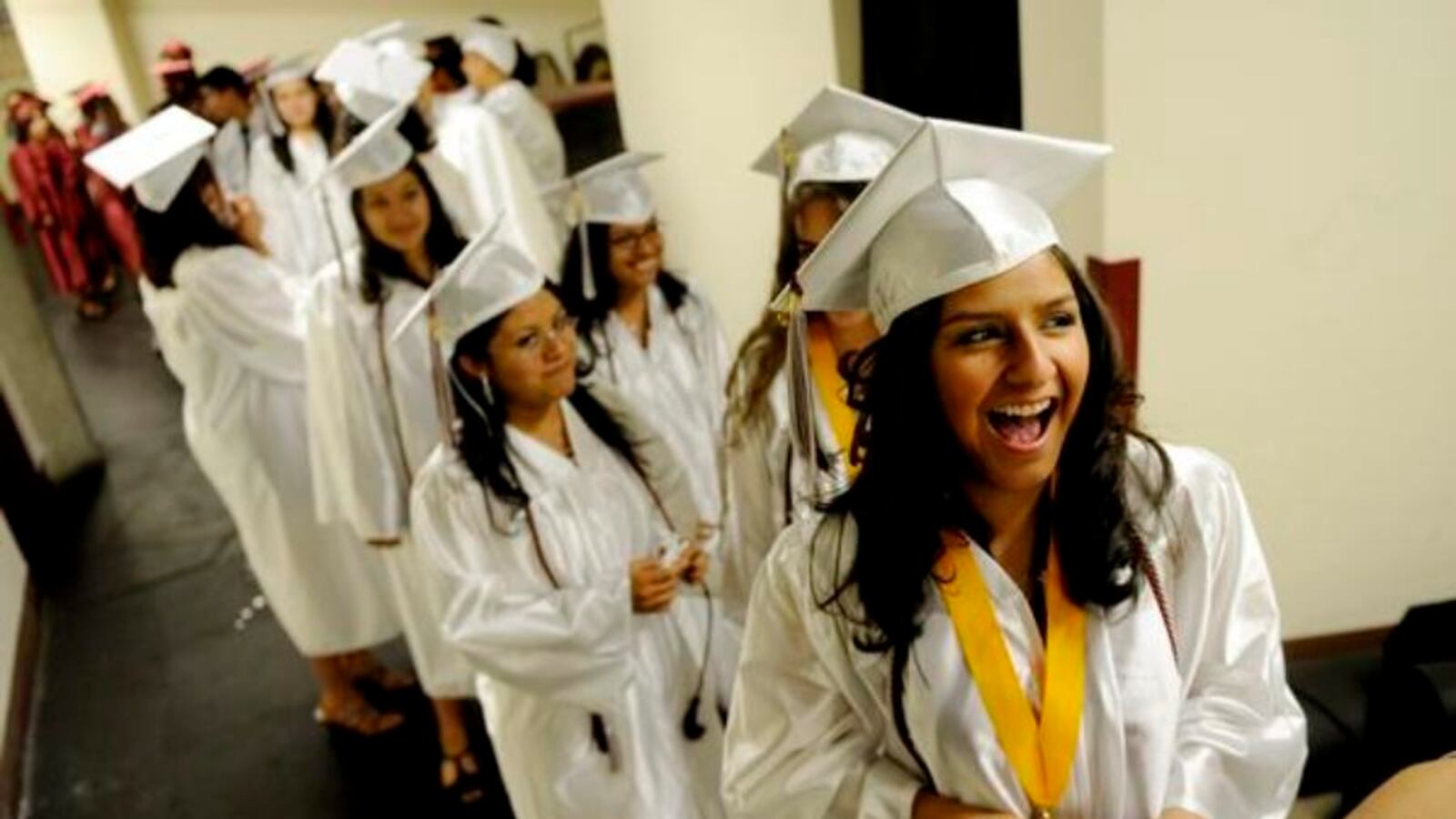Colorado’s four-year high school graduation rate reached a six-year high last year, with some metro Denver districts that serve at-risk students showing marked improvement and others taking steps back.
The on-time graduation rate for the class of 2016 was 78.9 percent, according to data released Thursday by the state education department. That’s a 1.6 percentage point jump from the previous year.
The state’s dropout rate also improved, falling by 0.2 percentage points. All told, 584 fewer students dropped out in 2015-16 than in the previous school year.
The state’s graduation gap between students of color and white students also narrowed slightly for the sixth consecutive year. The four-year graduation rate for students of color was 71.9 percent, an increase of 1.7 percentage points from last year. The graduation rate for white students in 2016 was 84.4 percent.
“The news is encouraging for the state and shows the continued dedicated commitment of students, parents, teachers and school staff,” Education Commissioner Katy Anthes said in a statement. “It is motivating that we are moving in the right direction as we all strive to have students graduate prepared for life after high school, whether that is in college or careers.”
Around the metro area, some school districts saw significant increases in their graduation rates.
Mapleton Public Schools, a district serving more than 8,000 students north of Denver, had the largest jump, posting a 64.6 percent on-time graduation in 2016, up from 57.1 percent in 2015.
Aurora, a school district that is struggling to improve before potentially facing state sanctions in another year, also made a significant jump — graduating 65 percent of their students in 2016, up from 59 percent in 2015.
Aurora Superintendent Rico Munn attributed his district’s gain to its new strategic plan, which requires each student to have a plan to graduate.
“If students take ownerships over their own success, there are higher levels of engagement and higher levels of success,” he said.
High schools in Aurora have also been rethinking how they keep students from dropping out. For example, at Hinkley High, students have the option of enrolling in a computer-based night school.
“I can tell you, there are no tricks,” Munn said, who added the district’s rate has steadily increased 20 points since 2010. “It’s been pushing a large rock up a hill. Not one magical jump.”
The graduation rates in both districts, despite the improvements still lag behind the state average and larger metro school districts like those in Denver and Jefferson counties. Jeffco Public Schools posted a graduation rate of 82.8 percent, virtually unchanged from the 82.9 percent in 2015. Denver’s graduation rate for 2016 is 67.2 percent, meanwhile, is up from 64.8 percent.
DPS officials celebrated their improved numbers at Kunsmiller Creative Arts Academy, a kindergarten through 12th school in southwest Denver that posted a 100 percent on-time graduation rate last year and had zero dropouts. DPS Superintendent Tom Boasberg hailed it as a “shining example,” a formerly struggling school reborn after being put on turnaround status.
Since the state changed the way it tracks graduation rates eight years ago, DPS’ four-year graduation rate has grown 70 percent, Boasberg said.
The graduation rates at another metro area district, Englewood Public Schools, climbed from 47 percent in 2015 to 54 percent in 2017. Diana Zakhem, the district’s director of postsecondary and workforce readiness, said the district has been working on improving graduation rates for years.
“It really is a combination of a lot of different things,” Zakhem said. “Focusing on student engagement, relevancy and relationships with them — all of those things have helped and contributed. It’s not just one thing that happens over one school year.”
The work at Englewood schools includes new career and technical courses including one in hospitality and culinary arts, an increase in the number of high school counselors paid for by grants, and work with a nonprofit that has a dedicated staff person tasked with finding students that do drop out to get them back in school.
Two metro area school districts, Sheridan and Westminster saw declines in their graduation rates.
Westminster, a school district that after one last appeal could become the first this year to lose accreditation because of chronic low performance, had a graduation rate of 56.3 percent, down from 59.4 percent in 2015.
Oliver Grenham, chief education officer for Westminster Public Schools said the district is not concerned with the four-year rate. Although just 56.3 percent of students in the district graduated after four years, another 190 students, or 27 percent, are still enrolled in the district.
“The number is not a surprise, in fact it’s what you would expect to see in a true Competency Based System where the goal is to ensure that a high school diploma has real value,” Grenham said of the four-year rate.
“We are pleased with our five- and six-year graduation rates because they show that our students who enter high school behind their peers are staying in school and learning what they need to know,” he said. “As a district, we would have a much higher graduation rate if we let students walk across the stage with a D average, but that would be a disservice to them and our community. Yes, more students would graduate in four years, but they would not be prepared for the future. We are not interested in playing the numbers game.”
The Sheridan School District just south and west of Denver had a 69.1 percent graduation rate, down from 75.9 percent in 2015.
The tiny Sheridan district this year jumped off the state’s accountability clock for low performance. Depending on how it fares 0n other measures, the decline in graduation rates could put the district on the state watch list again.

